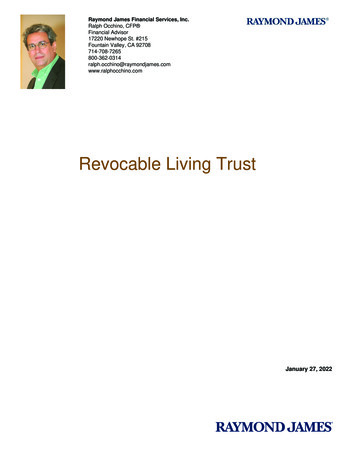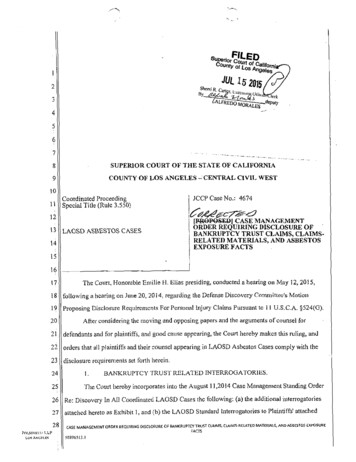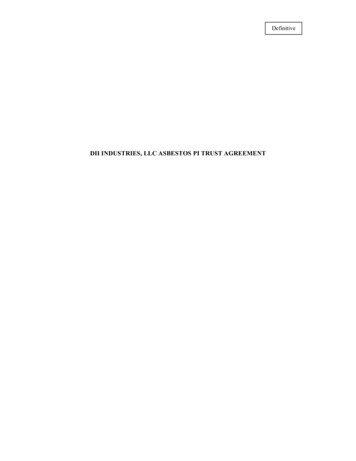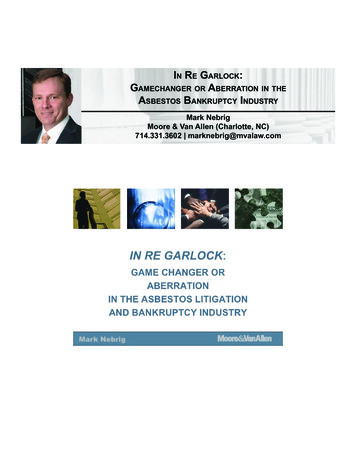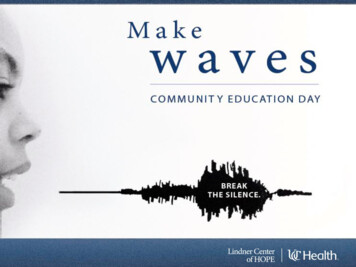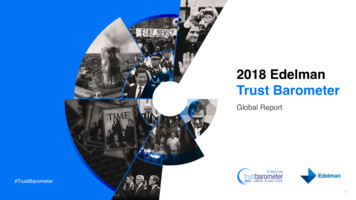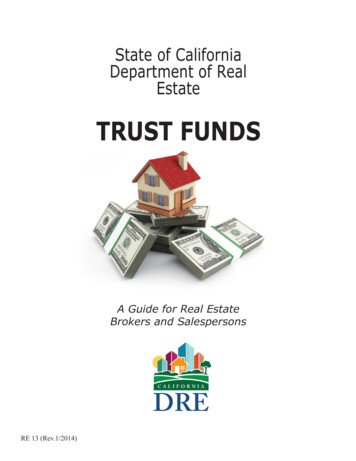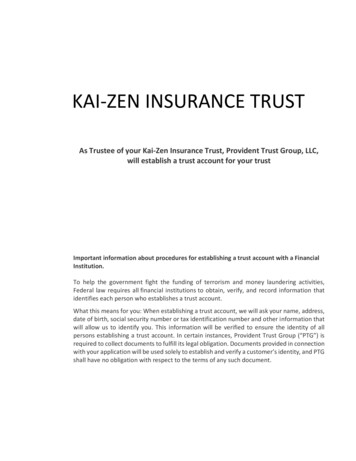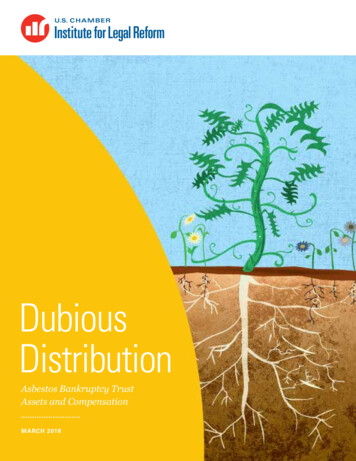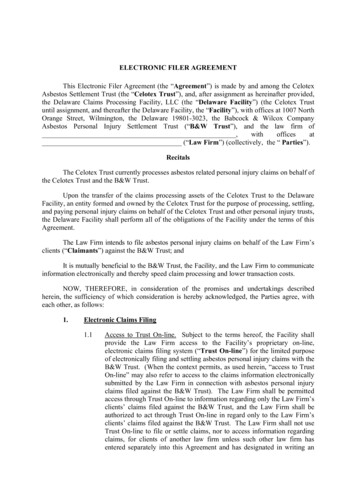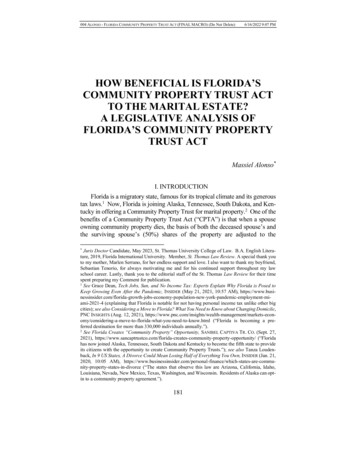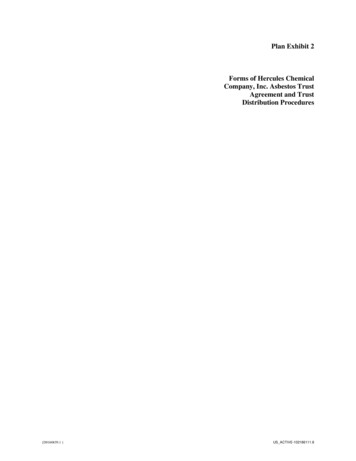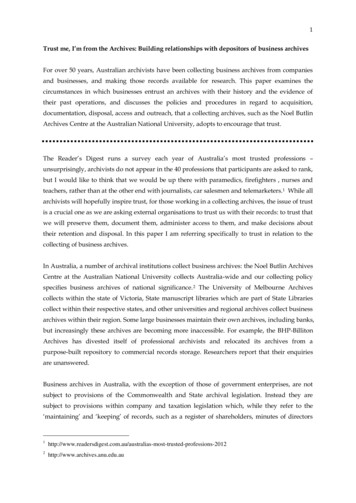
Transcription
1Trust me, I’m from the Archives: Building relationships with depositors of business archivesFor over 50 years, Australian archivists have been collecting business archives from companiesand businesses, and making those records available for research. This paper examines thecircumstances in which businesses entrust an archives with their history and the evidence oftheir past operations, and discusses the policies and procedures in regard to acquisition,documentation, disposal, access and outreach, that a collecting archives, such as the Noel ButlinArchives Centre at the Australian National University, adopts to encourage that trust.The Reader’s Digest runs a survey each year of Australia’s most trusted professions –unsurprisingly, archivists do not appear in the 40 professions that participants are asked to rank,but I would like to think that we would be up there with paramedics, firefighters , nurses andteachers, rather than at the other end with journalists, car salesmen and telemarketers.1 While allarchivists will hopefully inspire trust, for those working in a collecting archives, the issue of trustis a crucial one as we are asking external organisations to trust us with their records: to trust thatwe will preserve them, document them, administer access to them, and make decisions abouttheir retention and disposal. In this paper I am referring specifically to trust in relation to thecollecting of business archives.In Australia, a number of archival institutions collect business archives: the Noel Butlin ArchivesCentre at the Australian National University collects Australia-wide and our collecting policyspecifies business archives of national significance. 2 The University of Melbourne Archivescollects within the state of Victoria, State manuscript libraries which are part of State Librariescollect within their respective states, and other universities and regional archives collect businessarchives within their region. Some large businesses maintain their own archives, including banks,but increasingly these archives are becoming more inaccessible. For example, the BHP-BillitonArchives has divested itself of professional archivists and relocated its archives from apurpose-built repository to commercial records storage. Researchers report that their enquiriesare unanswered.Business archives in Australia, with the exception of those of government enterprises, are notsubject to provisions of the Commonwealth and State archival legislation. Instead they aresubject to provisions within company and taxation legislation which, while they refer to the‘maintaining’ and ‘keeping’ of records, such as a register of shareholders, minutes of es.anu.edu.au
2meetings and general meetings, and financial books of accounts, they are remarkably silent onhow long such records should be retained. One exception is section 286 of the CommonwealthCorporations Act 2001 which refers to the retention of financial records only: ‘The financialrecords must be retained for 7 years after the transactions covered by the records arecompleted.’3 Many companies rely on the legal statute of limitations, which may be 6 years or alonger period, depending on the nature of the material, as a guide to an appropriate retentionperiod. Records which are already or are likely to be involved in legal proceedings are requiredto be retained, but there is no legal requirement to retain business records for archival research.In these circumstances it may appear surprising that there are any business archives in Australiaat all.The first deposit of business archives in the Noel Butlin Archives Centre came in 1953. NoelButlin, an economic historian at the Australian National University, was holidaying in Newcastleand called in at the offices of the Australian Agricultural Company. This company was formed in1824 making it the second-oldest company in Australia (the Bank of New South Wales, nowWestpac, was formed one year earlier). He asked about their records and was informed that hewas just in time as they had gathered all the old records to dispose of as they were movingpremises. In later years he would recall a large quantity of records covered in coal dust, piled ina loading bay ready to be sent to be incinerated.4 These records along with the records from theLondon office of the Company acquired later are now one of our most valuable and usedcollections and are listed on the UNESCO Australian Memory of the World Register.It is significant to note that in 1953 the Australian National University was only seven years oldand had no archives itself. Butlin arranged for the transfer of the records to Canberra to enablehis own research, constructing a series of national accounting estimates and in particularcalculating private investment by Australian companies in the nineteenth century. The recordsof other companies were systemically sought in the next few years: the records of GoldsbroughMort and Company, Australian Estates Company, Australian Mercantile Land and FinanceCompany, Elder, Smith and Company, and Mort and Company are among those collected at thistime. These records supported Butlin’s work and that of colleagues in the Economic Historydepartment particularly in relation to the pastoral industry. In these early days, depositagreements were often simply conversations between the Professor (he became Professor ofEconomic History in 1962) and a member of staff with an exchange of correspondence to confirmtransfer th/consol act/ca2001172/s286.html4B Howarth and E Maidment (eds), Light from the Tunnel: Collecting the Archives of Australian Business andLabour at the Australian National University 1953-2003, Friends of the Noel Butlin Archives Centre, Canberra,2004, p. 34
3Obviously, trust is operating here: companies were trusting that Butlin and his academiccolleagues would use the records responsibly to undertake research of national importance. Thecompanies were happy not to have the problem of storing the records, and to make themavailable for this privileged but not public access. Butlin responded to an official visit by theNational Librarian Harold White, saying ‘firms were not willing to surrender confidentialrecords to a ‘public’ library while they were prepared to pass them over to a restricted accessrepository at a university.’5 White, by the way, had demanded that the State Libraries were theproper repositories for business archives and that the University should cease its operations inthis area.As the operation grew, professional archivists were employed and more formal arrangementsdeveloped: the basic terms were that the records continued to be owned by the company, thatthey were the final arbiters in terms of access and disposal, and that the Archives providedstorage in return for which the records were available for access by bona fide researchers.Assurances were given that, if the company wished, any work resulting from research could bevetted by the company prior to publication or submission of the postgraduate thesis. In practice,few companies exercised this right. An important point to note here is that the records ofcommercial rivals were being collected, and the archives was also now collecting the records oftrade unions.After that initial influx of records, transfers of business archives generally resulted fromtakeovers, mergers and reorganisations of companies. For example, the transfer of records byCSR Limited (formerly the Colonial Sugar Refining Company) concerned their extensivecane-growing and sugar refining operations in Australia and Fiji which were being sold off andare now wholly divested by the company. When Burns, Philp and Company, an existingdepositor, imploded and was forced to vacate its substantial headquarters in Bridge Street,Sydney a second much larger deposit of business records relating to their extensive operations inAustralia and the Pacific was transferred to the Archives.For our existing long-standing depositors, we seek to justify the original trust that they had inour academic colleagues and to demonstrate that archivists operate with professional standardsand that we will honour the spirit of the original agreements made between academic staff andcompanies.One challenge has been the emergence of genealogists as researchers. Though not mentioned, it5Noel Butlin, ‘Comments on Mr White’s visit to Director’, March 1957, reprinted in Archives and Manuscripts,vol. 19, no. 2, p. 151
4can be assumed that when companies originally agreed to access to their records by bona fidescholars, they would not have considered family historians within the definition of bona fidescholar. They would have been thinking of academic staff of the University, and postgraduatestudents under their supervision in the area of economic history or perhaps more broadly inAustralian political history. Perhaps social historians, labour historians and local historianswould have been included in the definition, but definitely not journalists. It is unlikely that theywould have foreseen the use of their records by heritage architects, industrial archaeologists,railway enthusiasts, biographers, and other research specialisations that are common today.And of course, today our academic researchers come from universities all over Australia andfrom other countries.So it has been necessary to renegotiate those informal agreements of the past. We have beensuccessful in doing so in most cases by earning the trust of company depositors that weunderstand their interests and also the interests of researchers wanting access to their records.The Australian Agricultural Company records for instance had until recently access conditionsallowing access only to pre-1959 material. I have mentioned before that we successfullynominated the records of the Australian Agricultural Company for the Australian Memory of theWorld Register, and the Chairman of the Company announced this with obvious pride in theCompany newsletter. With the support of the Company, we have preserved a number of earlyimportant archives of the Company – the despatches from the Australian to the London Office inthe 1820s were transcribed and published by the University’s E Press.6 Early unique maps of theCompany’s million-acre grant and other properties have been digitised and made availableonline, with the Company’s financial support.7 In this atmosphere of trust, after discussionswith the company about the restrictive access conditions, we presented evidence of more liberalpolicies relating to potentially more sensitive records, and the Company agreed to a 30-year rulewhich has opened up important material relating to their more recent operations.In relation to disposal, we also make recommendations to companies whose records we hold. Animportant part of building this trust is demonstrating our expertise and knowledge: indicatingthat, for instance, in other jurisdictions that records of this nature are authorised for disposalafter a similar period of time, and also that there has been no call to refer to the records forresearch either by the company itself or by researchers in the area.Our recent dealings with companies have focused on highlighting the promotional value of their6Available online at http://epress.anu.edu.au/titles/isc1 citation and http://epress.anu.edu.au/titles/isc citation7Available 5/31/browse?type dateissued&submit browse Issue date
5archives for their current operations. It is our practice to ask our depositors whenever we areasked to lend their records for an external exhibition: the Visions of Australia program hassponsored Australia-wide touring of a number of exhibitions featuring company records. Forexample, CSR Limited’s collection of photographs taken by celebrated Australian photographerMax Dupain have toured throughout Australia in a National Archives exhibition,8 and Elder,Smith and Company records featured in the ‘Muslim Cameleers’ exhibition developed andtoured by the South Australian Museum.9 In both cases, the company benefited from the freepublicity and good-will generated by their association with the exhibition.Our original depositors would also not have foreseen that access could be provided online andremotely, rather than to researchers visiting our reading room. We have a program ofdigitisation of photographs and maps which are then available online: again we ask ourcompany depositors before making these available to an online audience. Most are happy to giveus blanket permission though some wish to approve each image that is put online.Trust in the archives and in archivists is also valued by companies involved in currentcontroversies and litigation. An active research area over the last few years relates to cases ofworkers exposed to asbestos. In the case of one company that was involved in the manufactureof asbestos sheeting, we refer all requests for access, whether they relate to that division of thecompany or not, to the company for permission.We also hold the records of the Waterside Workers Federation and many members of this tradeunion were exposed to hazardous materials as part of their work. Not just from the loading andunloading of asbestos products but also bulk loading of wheat where the dust was injurious toworkers’ health. In Australia, Dust Diseases Tribunals hear these cases and we are asked toproduce the evidence of union membership. As for company records, we seek the permission ofthe current union the Maritime Union of Australia before releasing the records.Another recent challenge for collectors of business archives has been the identification byliquidators of monetary value attached to business records. Where once the records of defunctcompanies would be happily donated (and some still are), liquidators are now more likely toidentify that records with historic or nostalgic value might raise funds to offset demands bycreditors and to fund staff entitlements. For current companies, we seek a donation toaccompany the records and offset the initial cost of transportation, reboxing and documentation,and the ongoing costs of storage and access control. But if the company is in liquidation this dupain.aspx9http://www.cameleers.net/?page id 779
6not possible, and increasingly we are asked if we would be prepared to purchase collections. Itseems that the currency of trust is unfortunately losing value in the current economic climate.
7Paper Submitted to the Session “Business Archives - Sustainability, Trust and Identity”23 August 2012, the 17th ICA Congress, in Brisbane, AustraliaNeither Merger, Nor Acquisition, Nor Diversity,Nor Generational Change Can Stay Them:The Indispensible Role of Corporate Archives in the Identifying, Shaping, andPropagating of Corporate IdentityYuko Matsuzaki, PhDBusiness Archives Specialist,Resource Center for the History of Entrepreneurship,Shibusawa Eiichi Memorial FoundationTokyo, JapanIntroductionImage 1 illustrates the idea that business archives have multifaceted value and canserve as a tool for corporate management in a variety of ways. This idea was the focus of theSBL (Section for the Business and Labour Archives of the ICA) Tokyo symposium in May2011 and the resulting Japanese language publication and English language e-book. The latter,published electronically in July 2012, by the Resource Center for the History ofEntrepreneurship of the Shibusawa Eiichi Memorial Foundation, is a compilation ofpresentations delivered at the Tokyo symposium and other SBL seminars, and provides arange of case studies showcasing the ways in which business archives around the world arebeing leveraged for corporate benefit. (to download the full e-book or individual chapters rk/01 icasbl/Tokyo/leveraging.html)
8Image 1 – The Multifaceted Value of Business ArchivesThis paper focuses on just one of the many roles of corporate archives, that of theircontribution to the establishment and propagation of a corporate identity. In Japan this maybe referred to as keiei-rinen (経営理念), a term that encompasses corporate identity,philosophy, or principles. I learned about the importance many Japanese companies placeupon this concept in the course of research on the status of business archives in Japan in orderto compile a directory of Japanese corporate archives.To illustrate my discussion I will use two Japanese case studies, the corporatearchives of the consumer products company Kao and of the electric goods producerPanasonic. These two companies, leaders in their respective fields, use their archives indifferent ways to formulate a corporate identity that is then shared by the archives withmanagement, employees, and other stakeholders, even beyond the borders of Japan.Kao CorporationAs companies grow and expand, the establishment of a corporate identity and itspropagation among employees becomes an important issue. It is true not only when
9companies grow successfully, but even more so when they struggle to survive in difficultcircumstances such as recession. In the recent Japanese context, companies have beenattempting to fully utilize their resources in order to overcome the various difficulties thatresulted from the collapse of the overheated domestic stock and real estate markets. Now,more than ever, corporate archives are playing a significant role in reinforcing corporateidentity. The following case study of the corporate archives of the Kao Corporation willhopefully provide a useful example.In 1887, the founder of Kao, Mr. Tomiro Nagase, opened the Nagase Shoten, aWestern sundry goods store that would later become the Kao Group. In 1890, it startedmanufacturing and selling Kao Sekken, a high quality toiletry soap which became thecornerstone of Kao’s over one hundred years of history. Today the Kao Group consists of 100consolidated companies and is today a leading manufacturer of consumer products. Kao isactive in four main business segments: Beauty Care, Human Health Care, Fabric and HomeCare, and Chemical. The Group has its headquarters in Nihonbashi Kayabacho, Tokyo, and aworkforce of more than 34,000 employees. Listed on the Tokyo Stock Exchange, Kao had1,216 billion yen in consolidated net sales and an operating income of 108.5 billion yen infiscal 2011. The Group has offices in thirty countries and areas and operates in the markets of112 countries and areas worldwide.The Kao Archives is now in the Department of Corporate Culture and Literature,within the Corporate Communications Division, but the predecessor of the Archives datesback to the establishment in 1936 of an office for the preparation of a publication on the 50year history of the iconic brand soap, Kao Sekken, on the occasion of its 50th anniversary.Let me sidetrack for a moment to provide some background. Published volumes ofcompany history have long been used by Japanese companies as communications tools.These publications are known as shashi, a term that translates directly as “company history.”According to a shashi expert, more than 13,000 shashi were published between the end of the19th century and the beginning of the 21st century. Today more than 100 are published everyyear. The Kao Corporation has published numerous shashi over the years, starting with a 50year history in 1940, a 70 year history in 1960, an 80 year history in 1971, a 100 year historyin 1993, and a 120 year history in 2012. In addition to its uses as a communication tool, Kaoalso see shashi as a tool for internal branding.The regular publishing of shashi illustrates the great attention Kao has paid to itsheritage throughout the course of its development as a company. Kao’s interest in identity,however, did not exist from the beginning. Corporate philosophy was not clearly
10conceptualized as implicit knowledge until the mid 1990s, which was the time of recessionafter the collapse of the bubble economy in Japan. The period also saw a changing of theguard as a wave of retirements hit companies and the generation that was responsible forrapid economic growth, from the 1950s to the early 1970s, was replaced. For Kao, it was alsoa time when the workforce diversified due to the expansion of foreign operations as well aschanges in business areas. Over the decades, especially for the past 20 to 30 years, thecompany has been expanding its business through mergers and acquisitions in addition tolaunching new products through innovation. In 1988, Kao acquired the Andrew JergensCompany, which had its headquarters in Cincinnati, Ohio, in the United States, and in 2005, itacquired Molton Brown in London, the United Kingdom to name but a few. On the otherhand, Kao withdrew from manufacturing computer floppy disks in 1997, an industry in whichit had held a dominant position in world markets in the early 1990s.While the functions of the Kao Archives team were considered important within theCorporate Communication Division, in 1995, the top management, along with the CorporateCommunications team, established a corporate philosophy that was based on records andcorporate heritage. The team focused on the records of the founder and successivemanagements. The founder left a message such as “Good fortune is given to only those whowork diligently and behave with integrity.” The latter included texts titled ‘Five Points: Inwhich direction should the Nagase Store advance?’ written by Tomiro Nagase, Jr. in 1927.They are as follows: Is Kao Soap truly affordable and does it meet the needs of consumers? Is Kao Soap the best and of the highest quality? Is Kao Soap the best suited for the lifestyles of this new age? Are we working every day with our historical and cultural legacy and our mission inview? Is our style of management compatible with today’s society and consumers?This led to the realization of a management policy: the ‘Kao ManagementPrinciples’. This was further refined and, in 2004, released as ‘the Kao Way’. The Kao Wayconsists of the Mission, Vision, Values, and Principles that are in turn defined as follows:Mission: What we exist forVision: Where we want to goValues: What we believe inPrinciples: How we behave
11The philosophy incorporates three main values. The first is Yoki-monozukuri, a term that theArchives and Corporate Communications teams were unable to translate succinctly intoEnglish, but have defined as ‘a strong commitment by all members to provide products andbrands of excellent value for consumer satisfaction’. (See, for example, the Kao website:http://www.kao.com/jp/en/corp about/kaoway 02.html) Literally, ‘yoki’ translates to ‘good’or ‘excellent’, and ‘monozukuri’ refers to the development or manufacture of products. Thetwo other values, ‘Innovation’ and ‘Integrity’, were drawn from the records of the founderand former senior management.The Group used various methods to disseminate the new philosophy to theworkforce. The archives assisted by providing stories, case studies, and materials. In thespring of 2005, management launched the “Asia Harmonization Strategy” to integrate allAsian operations, a further opportunity for the corporate communications team to contributeto the propagation of the Kao Way. The corporate communications team conducted a series oftraining workshops on the Kao Way, originally targeting local branches and business unitsoutside Japan in order to share the corporate identity among the company’s diverse globalmembers. After conducting a pilot workshop in Malaysia, the team conducted the firsttraining in Thailand. Trainers at each subsidiary were trained by the corporatecommunications team and these trainers then conducted workshops at the local level todiscuss and deepen understanding of the Kao Way. Workshops have already been held in alllocal branches and business units in the United States, Europe, and Asia outside of Japan.Work is still ongoing on workshops within Japan.In 2007, Kao opened a corporate museum at their Sumida complex. The museumaims to enhance the understanding of corporate identity among all stakeholders, includingemployees, management, business partners, and customers as well.It should be noted that the Kao has been listed as one of the World's Most EthicalCompanies by the international think-tank Ethisphere Institute every year for 6 years sincethe list’s inception in 2007. (for more information see http://ethisphere.com/wme/ ) A recentlecture by Shunichi Nakagawa, at the time a Managing Executive Officer with Kao, theSenior Vice President, Legal and Compliance, and Corporate Communications, delivered atthe Business Archives Association of Japan’s AGM on May 24, 2012, emphasized that Kao’sachievements in the area of ethics are the result of the promulgation and use of the Kao Way.This would not have been possible without the Kao Archives.
12Panasonic CorporationA strong corporate identity also becomes important in the face of corporateacquisitions and integrations. The past two decades have been characterized by frequentrestructuring and mergers for many companies. In these situations the ability to continue toconduct business based on common principles and philosophies is vital and yet very difficult.Corporate archives, however, can provide invaluable resources to respond to these challenges.The following case study of the Panasonic Corporation will hopefully provides an example.The Panasonic Corporation was founded in 1918 by Konosuke Matsushita(1894-1989), a self-made man who quit school at the age of nine. His company is now aleading global electronics manufacturer and the largest general manufacturer of homeelectrical appliances in Japan. Panasonic has their headquarters in Osaka and a workforce ofwell over 360,000. Listed on the Tokyo, Osaka, Nagoya, and New York Stock Exchanges, theCorporation had consolidated net sales of 7,846.2 billion yen and operating income of 43.7billion yen in fiscal 2011.Within Panasonic there are two departments related to archives: the KonosukeMatsushita Museum and the Office of Corporate History. Both departments are located on thepremises of the Panasonic Headquarters in Kadoma, Osaka. The Museum opened in 1968 tocommemorate the 50th anniversary of the company and at the time it was under the directcontrol of the office of the CEO. It is open to the public and visited by approximately 35,000visitors annually. Half of this number are employees of the Panasonic Corporation. TheOffice of Corporate History, on the other hand, was established in 1976 in order to preparefor the 60th anniversary in 1978. The work of the Office centered around: 1) exploring thebusiness philosophy of the founder and sharing this information both internally and externally,2) exhaustively collecting and preserving all materials related to the company’s history, and3) compiling volumes of company histories, or shashi.The Office of Corporate History collects, appraises, arranges, describes, preserves,provides access to, and oversees reference of the historical materials held in the archives. Themost important task for archivists in the Office of Corporate History, however, is to chosematerials from their collections and create content to display in the Museum. The Panasonicarchivists create content based on corporate records and in line with management philosophyand corporate history. This content is then shared and passed down over generations, incooperation with top management. In particular, content focuses on how the business hascontributed to society at large and how past management overcame various crises. Their workis made possible by the fact that, right from the beginning, the founder, Konosuke Matsushita,
13was very keen on keeping records, both documents and audio-visual materials. This legacy isa great advantage for the archivists at Panasonic and assists them in creating content,especially when the records have been digitized. (for a sampling of the video footageavailable see http://panasonic.net/history/museum/special/video library.html)The Museum uses the content created by the archivists and holds special exhibitionstwice a year, in spring and autumn. These special exhibitions inspire the general public,employees, and even management executives through the use of a vast volume of materialssuch as written texts, audio materials, film footage, and documents relating to the founder’smanagement philosophy and ideals.A special exhibition entitled “Konosuke Matsushita’s Global Perspective: Quest forProsperity” was held from April 20 through July 15, 2011. The purpose of this specialexhibition is stated to provide for all the employees an opportunity to learn the nature of theglobal view of the founder, that their business should in any way contribute to bringwell-being to the poverty-ridden areas, at the establishment of a new corporate structure afterthe acquisition of the Panasonic Electric Works Co., Ltd. and the SANYO Electric Co., Ltd.in April 1, 2011. During this period, approximately 2,000 employees of SANYO Electric Co.,Ltd. visited the exhibition. One SANYO employee commented, “I had been disappointed thatthe company I worked for was taken over by the Panasonic Group, but after viewing theexhibition, I was truly inspired. I will continue to work hard. I would like to visit the museumagain.” This is just one voice, but it gives an example of how effective the Museum’sexhibitions, and by extension the content created by the archivists, can be in fosteringknowledge of and pride in Panasonic, both among the public and among employees. Theability to do this is especially important in sharing corporate philosophy with new employeesthat have joined the company through mergers and acquisitions.ConclusionA corporate archives is an important function within a company, providing answe
1 Trust me, I'm from the Archives: Building relationships with depositors of business archives For over 50 years, Australian archivists have been collecting business archives from companies
